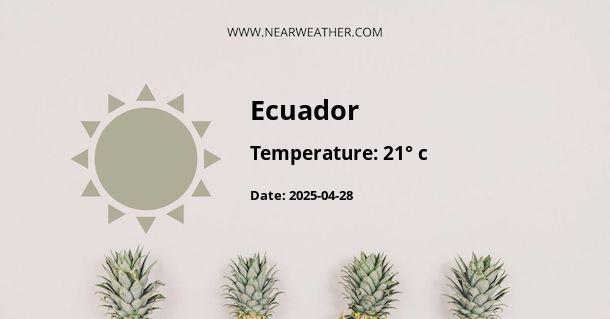Climate and Weather in the Republic of Ecuador
Ecuador, located on the equator in South America, boasts a diverse climate influenced by its unique geography. The country is divided into four distinct regions – the Andes Mountains, the Amazon Rainforest, the Pacific Coast, and the Galapagos Islands – each with its own microclimate and weather patterns. Understanding the climate and weather of Ecuador is essential for travelers and residents alike to prepare for the varying conditions throughout the year.
Andes Mountains Region
The Andes Mountains, with its high altitude, experiences cooler temperatures compared to the rest of the country. The climate here varies depending on the altitude. In the higher elevations, the weather is generally cooler, with temperatures averaging around 50°F (10°C). As elevation decreases, the climate becomes more temperate, with temperatures ranging from 68°F to 77°F (20°C to 25°C). The Andean region experiences a rainy season from October to May and a dry season from June to September.
Amazon Rainforest Region
The Amazon Rainforest region is characterized by its hot and humid climate. Temperatures in this region remain fairly consistent throughout the year, typically ranging from 77°F to 91°F (25°C to 33°C). The area experiences heavy rainfall year-round, with a particularly wet season from April to July and another rainy period from November to January. The humidity in the Amazon region can reach as high as 85% to 95%.
Pacific Coast Region
The Pacific Coast region of Ecuador experiences a tropical climate with high temperatures and humidity. Temperatures along the coast range from 75°F to 91°F (24°C to 33°C). The weather in this region is influenced by the Humboldt Current, which brings cooler temperatures during the dry season (June to September) and warmer temperatures during the wet season (December to May). The wet season is characterized by heavy rains and occasional flooding, particularly in low-lying areas.
Galapagos Islands Region
The Galapagos Islands, located west of the Ecuadorian coast, have a unique climate due to their isolation. The islands experience a subtropical desert climate with minimal temperature variations throughout the year. Average temperatures range from 70°F to 84°F (21°C to 29°C). The islands have two main seasons – the hot or wet season from December to June, and the dry or garúa season from June to November. The garúa season brings cooler temperatures and a light mist, creating a distinct climate pattern.
Overall Climate Summary
Ecuador's climate is heavily influenced by the Andes Mountains, the Pacific Ocean, and the country's position on the equator. The diverse geography and microclimates result in a wide range of weather patterns throughout the country. Travelers to Ecuador should be prepared for these diverse conditions and pack accordingly to ensure a comfortable and enjoyable experience.
Weather Averages by Region
| Region | Average Temperature | Wet Season | Dry Season |
|---|---|---|---|
| Andes Mountains | 50°F to 77°F (10°C to 25°C) | October to May | June to September |
| Amazon Rainforest | 77°F to 91°F (25°C to 33°C) | April to July, November to January | N/A |
| Pacific Coast | 75°F to 91°F (24°C to 33°C) | December to May | June to September |
| Galapagos Islands | 70°F to 84°F (21°C to 29°C) | December to June | June to November |
It's important to note that these are average temperatures and seasons, and variations can occur from year to year.
Climate-Related Challenges
While Ecuador's diverse climate offers a range of experiences for visitors, it also presents certain challenges. The varying weather patterns can lead to issues such as landslides in the Andes, flooding along the coast, and transportation disruptions during the wet seasons. Additionally, the high humidity in the Amazon region can be uncomfortable for some individuals. Understanding these climate-related challenges is crucial for ensuring the safety and well-being of both residents and tourists.
Conclusion
Ecuador's climate is as diverse as its geography, offering a unique experience for travelers and residents alike. From the cool temperatures of the Andes to the hot and humid climate of the Amazon, each region presents its own set of weather patterns and challenges. Being prepared for the varying conditions throughout the year is essential for anyone visiting or residing in this beautiful country.
By understanding the climate and weather patterns in Ecuador, individuals can make informed decisions about when and where to travel, what to pack, and how to navigate the country's diverse landscapes. This knowledge enhances the overall experience of exploring all that Ecuador has to offer.
A - Ecuador's Latitude is -2.000000 & Longitude is -77.500000.
A - Weather in Ecuador is 21° today.
A - Climate Conditions in Ecuador shows light rain today.
A - Humidity in Ecuador is 94% today.
A - Wind speed in Ecuador is 2.45 km/h, flowing at 317° wind direction. today.
